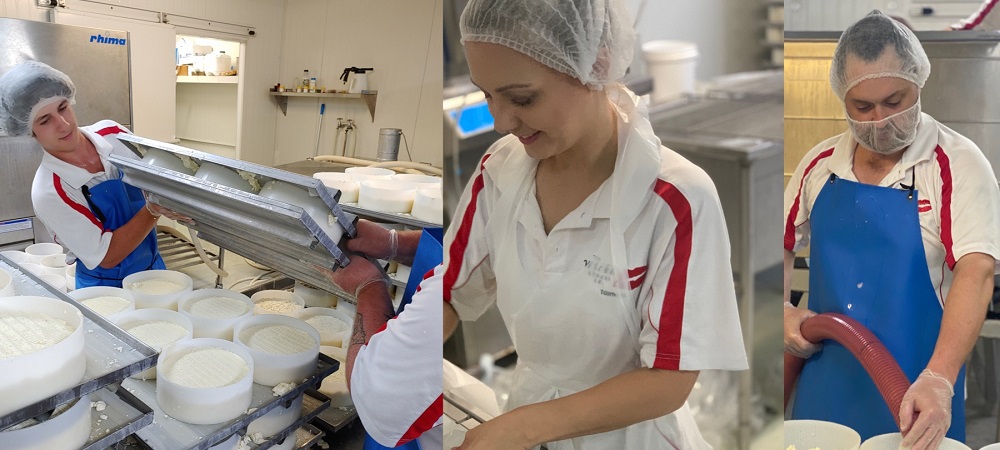Discovering Melbourne Made Cheese: Why Floridia Cheese Is a Must-Try
Discovering Melbourne Made Cheese: Why Floridia Cheese Is a Must-Try
Blog Article
Opening the Keys of Artisanal Cheese Making: A Step-by-Step DIY Overview
In the world of cooking craftsmanship, artisanal cheese making stands as a testament to the delicate balance in between tradition and advancement. As we get started on this journey to demystify the art of developing charming cheeses, we are encountered with a tapestry of abilities and keys waiting to be unraveled.
Picking the Right Milk
When beginning on the journey of artisanal cheese production, the selection of milk plays an essential duty in figuring out the quality and attributes of the final item. The type of milk picked influences the flavor, appearance, and generally profile of the cheese.
In addition, the source of the milk, whether from cows, goats, lamb, or buffalo, adds unique tastes and features to the cheese. Each type of milk brings its own nuances, enabling for a broad variety of cheese selections to be crafted based on the selected milk.
Culturing and Coagulating
To launch the cheese-making procedure, the vital actions of culturing and coagulating must be meticulously carried out to change milk into curds and whey. The kind of culture utilized can dramatically affect the taste, appearance, and ripening of the final cheese product.

The timing and temperature level control throughout culturing and coagulation are crucial variables that influence the last result of celebrity. Correct execution of these actions is important to guarantee the desired appearance, taste, and consistency of the artisanal cheese being generated.
Draining and Pressing Curds
After the milk healthy proteins have coagulated and the curds have actually been cut to release whey, the next vital action in artisanal cheese making involves draining and pressing the curds to achieve the desired appearance and consistency of the final cheese product. The time for draining can differ depending on the kind of cheese being made and the desired wetness web content.
When the curds have actually sufficiently drained pipes, the next step is pressing. Pushing helps get rid of any remaining whey and compacts the curds to develop a strong cheese wheel. Pressing can be done using specialized cheese presses that use constant and gentle pressure over a period of time. The duration and stress used during pushing will certainly useful source influence the final texture of celebrity, from soft and velvety to difficult and company. Proper draining pipes and pressing are important steps that considerably influence the top quality and characteristics of the artisanal cheese being generated.
Aging and Flavor Methods
Carrying out meticulous aging and flavor techniques is essential in enhancing the depth and complexity of artisanal cheeses, raising their taste profiles to charming levels of refinement and elegance. Aging plays a critical role in developing the unique flavors and textures that differentiate artisanal cheeses. During the aging procedure, cheeses are stored in meticulously regulated atmospheres where aspects such as moisture, air flow, and temperature are adjusted to urge the development of valuable molds and germs. This regulated environment permits celebrity to mature slowly, establishing complex fragrances and abundant tastes.
Flavoring techniques also contribute significantly to the last taste of artisanal cheeses. Cheesemakers may choose to introduce additional flavors by including components such as herbs, spices, and even fruits right into the cheese during the manufacturing process. Additionally, some cheeses are cleaned or rubbed with numerous liquids, such as brine or alcohol, to improve their appearances why not find out more and flavors.
Wrapping and Keeping Cheeses

Conclusion
In final thought, understanding the art of artisanal cheese making involves carefully picking the ideal milk, following exact culturing and coagulating procedures, draining and pressing curds efficiently, and using numerous aging and flavoring techniques. Keep in mind to cover and her response keep your cheeses effectively to make certain optimal taste and structure development.
Each type of milk brings its own nuances, enabling for a large range of cheese varieties to be crafted based on the picked milk.After the milk proteins have actually coagulated and the curds have actually been cut to launch whey, the following crucial action in artisanal cheese making entails draining and pressing the curds to attain the preferred appearance and uniformity of the last cheese product. Most cheeses need to be covered in wax paper or cheese paper to permit them to breathe while shielding them from drying out. For cheeses that need to proceed aging, such as bloomy rinds or washed peels, ensure they are stored in an awesome atmosphere like a cheese cave or a refrigerator established to the appropriate temperature level. By paying attention to the covering and storage space of artisanal cheeses, cheese manufacturers and enthusiasts can protect the honesty of these delicacies and fully appreciate their intricate flavors.
Report this page